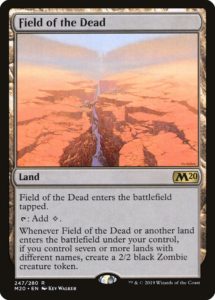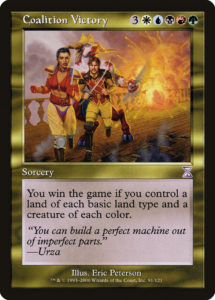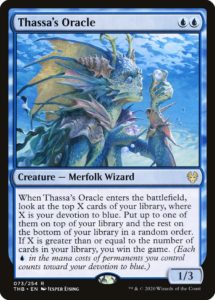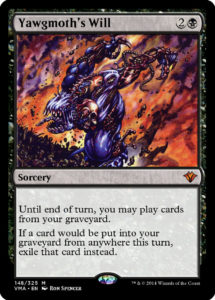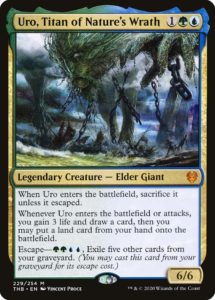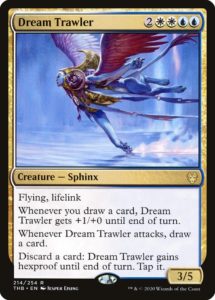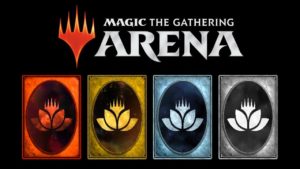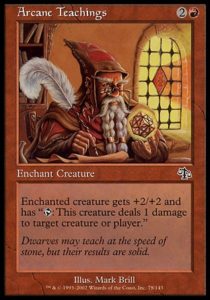Today, let’s talk about powerful cards. Power is integral to Magic being fun. It’s exciting, and powerful cards create exciting swings, memorable game moments; the “I’m saved” moment when the cavalry appears (or is topdecked) the moment before all hope is lost. Power is also dangerous, since too-strong cards warp formats around themselves, damaging Limited formats and in the worst case scenario, necessitating Standard bans. The more powerful a card or a format is, the more risk they bear of being broken.
Magic will always have more powerful cards and weaker cards—it’s simply not possible to have a fun, balanced Limited or Constructed format where every card has an equal power level (unless you want Magic to only print a few dozen cards each year). The challenge for Wizards is getting the balance right so the most powerful cards don’t dominate the metagame. In general, it’s better for Magic to err on the riskier side of making cards being a little too good rather than never having to ban cards (you can only play it safe when you’re not innovating, and if you’re not innovating, you’re stagnating, the riskiest thing a game can do). Lately, we’ve seen Magic err on the riskier side a bit more, and it has been a deliberate choice.
2019: Power Creeps Upwards
We’ve perhaps seen more Eternal-defining cards in 2019 than in any other year—this side of Urza’s Saga, anyway—and much of this has been by design. Modern Horizons introduced more powerful Eternal cards than any Commander, Conspiracy, or Battlebond set did. But the most important change was Play Design’s decision to juice up Standard expansions, starting with Throne of Eldraine. They confirmed this in a November article which accompanied the Standard bannings of Oko, Thief of Crowns, Once Upon a Time, and Veil of Summer. That banning was the second of 2019, quickly following the October banning of Field of the Dead. These Standard interventions ended the period of calm that began in January 2018 (when Rogue Refiner, Attune with Aether, Ramunap Ruins, and Rampaging Ferocidon were banned, capping off one of the most tumultuous years for Standard ever).
Play Design succeeded at their goal of in making more cards relevant in nonrotating formats and increasing the power level of Standard. While individual Eldraine cards hit higher than intended, their present plan is to keep sets at a similar power level. So, even if they’d wanted to course-correct and power down Standard a bit, we wouldn’t see those efforts until Core 2021 at the earliest; but we’re likely to see the current paradigm persist for the time being. Just as Throne of Eldraine introduced a slew of powerful cards, so has Theros Beyond Death. And there’s no place better to start than with the most powerful effect of them all.
You Win the Game
There are currently 31 cards which say, “You win the game.” That is the most powerful ability a Magic card can have (excepting perhaps Ashnod’s Coupon). There are few more dangerous or exciting effects to put on a card. (Cards like Stasis and Tetzimoc, Primal Death are arguably more dangerous, since they can essentially say “You win the game, but your opponent keeps playing a miserable game in the vain hope that you might not win.”) The majority of these win the game during your upkeep, so your opponent has some opportunity to react and interact before all is decided. Seven cards do not have upkeep triggers*. These are even more dangerous, since your opponent has little to no ability to stop you, and unlike an instant win combo like Splinter Twin plus Pestermite, once the one card resolves, the game just ends.
*Okay, technically nine do. There’s also Amulet of Quoz (a silly Ice Age throwback which involves both ante and a coin flip deciding the game) and The Cheese Stands Alone (a silver-bordered card with an incredibly difficult condition which then printed as Barren Glory).
Coalition Victory and Approach of the Second Sun balance their power by requiring large, unwieldy amounts of mana alongside a second condition. Biovisionary provides a small window of interaction but also requires you to have found, cast, and protected all four copies of Hurloon Minotaur (not exactly a Spikey combo mage’s dream scenario). Maze’s End effectively has an upkeep trigger, since it enters the battlefield tapped and requires you to have nine other lands in play. Despite these cards’ restrictions, several of them have nevertheless been played at Pro Tours; so players are willing to endure filling their decks with gates or casting multiple seven mana do-nothing sorceries in service to winning the game.
This brings us to the three card chain of Laboratory Maniac, Jace, Wielder of Mysteries, and Thassa’s Oracle, all of which have been used as tournament win conditions. Lab Maniac was an exciting build-around in Innistrad (and Ultimate Masters) Limited and a fine way to win with Spider Spawning if you couldn’t draft the namesake card. In Eternal, it gave self-mill decks and Doomsday a way to win quickly, thanks to cards like Dread Return and Gitaxian Probe. All of this power was stapled onto a Gray Ogre (one of the less Constructed-playable and more fragile set of stats), so you weren’t happy to play it unless you were all-in on winning the game immediately).
Jace, Wielder of Mysteries took things a bit farther by combining Lab Maniac‘s ability with a synergistic card advantage engine. The intent was presumably that a 1UUU Planeswalker with no built-in protection or other loyalty ability wouldn’t be quite good enough in the era of Teferi, Hero of Dominaria, but it was a viable win condition in Standard Kethis Combo, arguably the best deck in Standard prior to the 2019 rotation. With that, we’ve finally reached the card that inspired this article.
Thassa’s Oracle
Lab Maniac created a cool new ability. Jace, Wielder of Mysteries innovated by putting that ability on a card you weren’t unhappy to have if it wasn’t winning the game immediately. Thassa’s Oracle‘s innovation is slicing off half of the mana cost (the same innovation which gave us Veil of Summer). At two mana, Thassa’s Oracle requires less mana than any other instant-win condition ever.
The instant-win text was almost removed by Aaron Forsythe (as told in an awesome article by Mark Gottlieb), but kept for the sake of coolness and the card feeling sufficiently rare. In the abstract, I agree that it’s a cool, splashy line of text and without it the card would feel like an uncommon cousin to Augur of Bolas. But I don’t think cards like this should ever exist—regardless of how hard the hoop is to jump through, Thassa’s Oracle is just too inexpensive and too acceptable on its own for a card that says “you win the game.”
I think Thassa’s Oracle is a consequence of three things: Jace, Wielder of Mysteries blurring the lines of what’s acceptable, a dictate to power up cards (including ones that normally wouldn’t be meant for Standard), and a loss of institutional knowledge within Play Design about effects to be extra cautious about. I’m worried that cards like this can be printed and will continue to be printed in the future.
I will note that Thassa’s Oracle has done no damage to Standard whatsoever. That’s the only Constructed format which Play Design regularly tests, and it shows they did their due diligence in playtesting. But as game designers, I think it’s incumbent on us to restrict the most powerful effects to hard-to-utilize cards, not 1/3s just below the mark of playability. That just makes for a better play experience.
Again and Again
Underworld Breach is a messed up card. It’s a sexy one that hearkens back to one of the most powerful combo pieces of all time, but it’s still bonkers. As with Thassa’s Oracle, it’s done no damage to Standard, but unlike our UU friend, it clearly wasn’t designed with Standard in mind. Play Design has made it clear that they want to print more cards for nonrotating formats, and no card does so as loudly as this twist on Yawgmoth’s Will—that also costs less mana and doesn’t restrict you to recasting a spell once. It shouldn’t be surprising that the two best decks in Pioneer are designed around these two Theros Beyond Death cards, nor should it be surprising that both decks live under the fear of the banhammer.
The most worrying thing about Underworld Breach (and other Eternal-only plants like Wrenn and Six) is that they’re designed to be busted in way that Standard playtesting won’t address. If every set contains just one card of this caliber, formats like Pioneer and Modern are likely to drastically shift with every set release, and then do so again as cards get banned. That’s not why most people get into these formats and I’m worried what will happen when Play Design continually tries to shake them up vigorously. It’s a good thing that they’re designing cards with these formats in mind, but a dangerous thing when they intentional release pushed cards that could way overshoot the mark.
…and again
Uro, Titan of Nature’s Wrath and Kroxa, Titan of Death’s Hunger are new takes on the M11 Titans. Instead of costing six mana and only dying to Mana Leak, these Elder Giants are cheaper and recursive to offset their being multicolor and having a hoop to jump through.
I admit to being absolutely terrified of what Uro would do what it was first spoiled (and was shocked to see another insane Simic mythic in the same Standard as Hydroid Krasis and Oko, Thief of Crowns). The jury’s still out about just how format-warping it is, but I admit to feeling like Play Design hit the sweet spot here despite making recursive, inexpensive, card advantage-generating threats.
Time will tell whether they’re too good for Pioneer (or Standard), but I wanted to mention them as success stories—Play Design should be printing risky, exciting things, and splashy mythics are supposed to get people excited to crack packs. Whether these Titans are too good for Standard isn’t up to me to decide, but I much prefer cards intended for heavy Standard play (which will see tons of playtesting) get the bump than cards like Underworld Breach.
When there’s no room at mythic, the rares shall walk the Earth
Niv-Mizzet, Parun is one of the strangest Magic cards I’d seen in a while. If you hid his rarity from me, I’d have read his powerful suite of four abilities and conclude he was obviously a mythic (difficult mana cost notwithstanding). However, he was bumped down from mythic because Ral, Izzet Viceroy was in the set, and Ravnica sets have some of the tightest limitations of cycles (that’s what caused Emmara Tandris to swap cards with Voice of Resurgence the first time we met Dack). The following set, War of the Spark, saw normally mythic rare Planeswalkers pushed all the way down to uncommon and dialed complexity up to 11, so cards like Teferi, Time Raveler, Sarkhan the Masterless, and Nissa, Who Shakes the World were rare.
Theros Beyond Death continues this trend with cards like Phoenix of Ash and Dream Trawler. They would normally be mythic for their Constructed potential and devastating effects on Limited, but were printed at rare (probably because Ox of Agonas and Kiora Bests the Sea God took their mythic slots). It’s good for Magic if Constructed all-stars can be rare and not all concentrated at mythic, but Theros Beyond Death Limited is painfully affected by its preponderance of bomb rares that seem pushed for Constructed with their cheap costs and devastating effects. This is a side effect of juicing a larger portion of the cards in a set and one that worries me about Limited going forward. Limited should have bombs, but cheap, deal-with-me-immediately-or-die cards like Nadir Kraken and nigh-impossible-to-answer cards like Dream Trawler can lead to preventably frustrating play experiences.
The Arena Effect
Riskier designs potentially lead to more bannings, and bannings are bad for Magic, right? Well, one could argue that Arena mitigates a banning’s damage. If it’s cheap or free to build a Standard deck and Wizards can repay you for your trouble with a few wildcards, does the banning really hurt all that much? Maybe you’re out $10 and some hours of grinding, but that grind was playing Magic, y’know, the game that we love to play. Perhaps a higher powered Standard is worth the risk of more bans, since the damage hits far less hard.
Sure, A lot of people still play paper Standard and the bannings hurt them just as badly as ever. But Magic may will be transitioning to a very different business model, one where more competitive play and most of Standard is online, leaving organized paper play defined by casual, Commander, and other nonrotating formats. If this comes to pass, Magic will be substantially different, as will the market for Standard expansions. Such a world would require an ever-increasing amount of cards printed for these other audiences, and as argued with Underworld Breach, it’s incredibly dangerous for Wizards to print Eternal-focused cards with little to no Eternal playtesting. Sure, it makes for good Pioneer coverage if the format changes drastically each set, but that’s hard for a nonrotating format to do, and can be damaging when it happens (which it did for Modern in 2019).
It’s been interesting watching Play Design’s effects on Magic. They quickly turned around the pretty erratic era of 2016-2017 with the outstanding release of Dominaria. Guilds of Ravnica introduced one of the better Standard formats in years (despite some issues with Best-of-One at the Mythic Invitational and Nexus of Fate). They produced a whole bunch of silver bullet Modern answers in Core 2019 without breaking anything. And then halfway through 2019, they pushed the envelope even more, pushing cards like Fires of Invention—I seriously would never have expected an Omniscience variant to cost only four mana.
Time will tell what the next few sets and their paradigms will be, but I’m a bit nervous what’s going to happen before we can see how they reacted to the data from Throne of Eldraine and now Theros Beyond Death. But, time will tell, and for now, all I can do is wait for Mystery Boosters to release at my LGS.
Until then, and as always, thanks for reading.
—Zachary Barash is a New York City-based game designer and the commissioner of Team Draft League. He designs for Kingdom Death: Monster, has a Game Design MFA from the NYU Game Center, and does freelance game design. When the stars align, he streams Magic (but the stars align way less often than he’d like).

